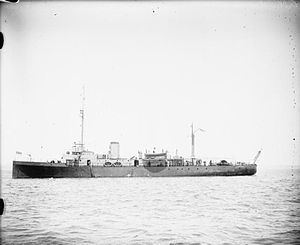Laid down 1 January 1917 Fate Sold 13 March 1947 Beam 28 ft 6 in (8.69 m) Launched 29 April 1918 Draft 2.29 m | Commissioned 3 October 1918 Displacement 800 long tons (813 t) Construction started 1 January 1917 Length 70 m | |
 | ||
Class and type Hunt-class minesweeper, Aberdare sub-class Builder Ailsa Shipbuilding Company | ||
HMS Aberdare was the name ship of her sub-class of the Hunt-class minesweepers built for the Royal Navy during World War I. She survived both World Wars to be scrapped in 1947.
Contents
Design and description
The Aberdare sub-class were enlarged versions of the original Hunt-class ships with a more powerful armament. The ships displaced 800 long tons (810 t) at normal load. They measured 231 feet (70.4 m) long overall with a beam of 26 feet 6 inches (8.1 m). They had a draught of 7 feet 6 inches (2.3 m). The ships' complement consisted of 74 officers and ratings.
The ships had two vertical triple-expansion steam engines, each driving one shaft, using steam provided by two Yarrow boilers. The engines produced a total of 2,200 indicated horsepower (1,600 kW) and gave a maximum speed of 16 knots (30 km/h; 18 mph). They carried a maximum of 185 long tons (188 t) of coal which gave them a range of 1,500 nautical miles (2,800 km; 1,700 mi) at 15 knots (28 km/h; 17 mph).
The Aberdare sub-class was armed with a quick-firing (QF) four-inch (102 mm) gun forward of the bridge and a QF twelve-pounder (76.2 mm) anti-aircraft gun aft. Some ships were fitted with six- or three-pounder guns in lieu of the twelve-pounder.
Construction and career
HMS Aberdare, named after the eponymous Welsh town, was built by the Ailsa Shipbuilding Company at its shipyard in Troon, Ayrshire. She was launched on 29 April 1918, and completed on 3 October 1918.
Aberdare was sent to the Mediterranean Sea on commissioning, joining the British Aegean Squadron, but was paid off into reserve at Malta on 26 November 1919.
In 1943 Aberdare was part of the 2nd M/S Flotilla based at Alexandria. During that year the flotilla swept minefields outside Mersa Matruh and other harbours in Libya, and off Malta and the south coast of Sicily. From January to September 1944 the flotilla was engaged in sweeping an inshore channel from Taranto round the heel of Italy and thence up the Adriatic coast as far north as Ancona.
